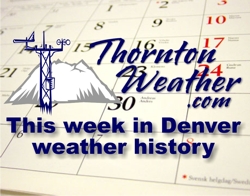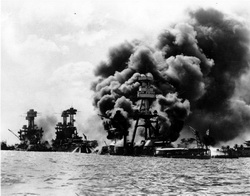
Our look back at this week in Denver weather history carries with it one overriding condition – wind. In January it is not uncommon for us to experience Chinook winds which are a blessing and a curse. These winds bring warm temperatures which are welcome in our coldest month of the year. However they also can run at extraordinary speeds and at their worst cause a great deal of damage.
13-16
In 1888…a cold air mass settled over the city and caused temperatures to plunge well below zero on four consecutive days…but only one temperature record was set. Minimum temperatures dipped to 4 degrees below zero on the 13th… 19 degrees below zero on the 14th…20 degrees below zero on the 15th…and 11 degrees below zero on the 16th. The maximum temperature of only 4 degrees below zero on the 14th was a record low maximum for the date. North winds were sustained to 30 mph on the 13th.
14-21
In 1930…a protracted cold spell occurred when low temperatures plunged below zero on 8 consecutive days. The coldest low temperatures of 20 degrees below zero on the 17th and 19 degrees below zero on the 16th were record minimums for the dates. High temperatures during the period ranged from 18 on the 18th to zero on the 20th. Two degrees on the 15th was a record low maximum temperature for the date.
15-16
In 1967…a major windstorm struck Boulder. The storm was described at the time as the worst single windstorm in the history of Boulder in terms of damage. Winds reached 125 mph at the National Center for Atmospheric Research and at Boulder airport. Winds gusted to 84 mph downtown. Damage totaled a half million dollars in Boulder where some minor injuries were reported. At the Boulder municipal airport… 14 light airplanes were severely damaged. The second floor of a warehouse was blown down…damaging two nearby moving vans. A mobile home was blown over south of Boulder… Injuring one woman. The roof of a department store was blown in. There was widespread damage to houses…autos… And power lines from wind and flying debris. Strong winds also occurred in Denver and Golden…but damage was only minor. At Stapleton International Airport…west winds gusted to 43 mph on the 15th and to 45 mph on the 16th.
In 1981…heavy snow of 6 to 10 inches accumulated across metro Denver. Snowfall totaled only 1.8 inches at Stapleton International Airport where east winds gusted to 21 mph on the 15th.
In 1991…a Pacific storm system moved across metro Denver. Snowfall totaled 3 to 7 inches with 3 inches in Aurora… Denver…and Castle Rock…4 inches in Arvada…and 7 inches at South Platte station just southwest of Denver. Snowfall totaled only 2.9 inches at Stapleton International Airport where north winds gusted to 21 mph on the 16th.
In 2001…heavy snow fell across the Front Range foothills and urban corridor. The combination of careless driving and snowpacked highways resulted in 3 multi-vehicle accidents involving 30 vehicles…along I-25 in Douglas County. Eleven people were injured and one was killed. Snow amounts included: 11 inches in Evergreen; 10 inches at Eldorado Springs and Genesee; 8 inches at Broomfield… Ken Caryl Ranch…and Thornton; and 5 to 7 inches in Arvada…Bailey…Crow Hill…Gross Reservoir…Lakewood… Louisville…Westminster…and near Loveland. Snowfall totaled 2.7 inches at the site of the former Stapleton International Airport.
Continue reading January 16 to January 22 – This week in Denver weather history



